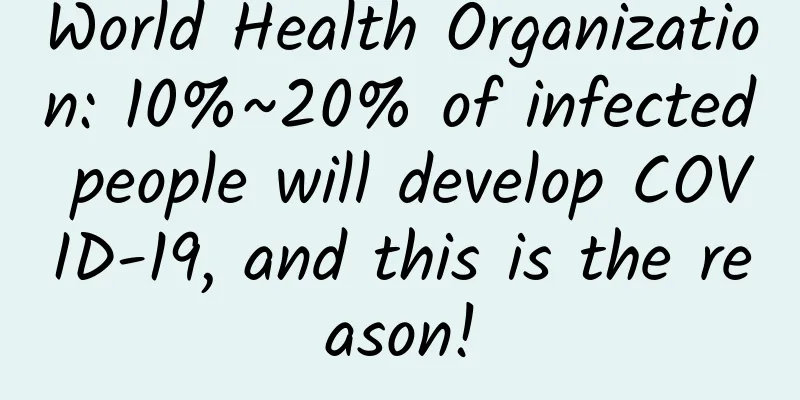World Health Organization: 10%~20% of infected people will develop COVID-19, and this is the reason!

|
As the first batch of patients infected with the new coronavirus turned positive, a "common" phenomenon gradually emerged at the beginning of the new year, that is, they felt fatigue and body aches after turning negative... In society, most people are more worried about the emergence of sequelae while being "healthy". In fact, Academician Zhong Nanshan has repeatedly stated in interviews that the above symptoms are not sequelae . Subsequently, a new term was proposed in the clinic - "long COVID-19" . So, what is COVID-19? What is its mechanism? How to prevent it? The editor has answered these questions one by one by reading the literature. Question 1: What is COVID-19? Most people infected with the new coronavirus will still have symptoms such as coughing, expectoration, fatigue, body aches, and memory loss after the nucleic acid test turns negative. These phenomena are often referred to as COVID-19 sequelae in news reports. However, the clinical definition of sequelae is: a defect or functional disorder of a certain tissue or organ left after the condition improves. Therefore, the above symptoms do not qualify as "sequelae". On December 9, 2022, Academician Zhong Nanshan said in an interview with the media that the various so-called "new crown sequelae" reported at home and abroad are mostly subjective personal feelings, such as general fatigue, weakness, depression, inability to concentrate, memory loss, and temporary loss of smell and taste. However, these symptoms will improve or even disappear over time , so they cannot be considered new crown sequelae. At present, there is no clear evidence that the Omicron variant, as the main strain of the new coronavirus in China, will cause sequelae after infection. Therefore, the more accurate expression of symptoms such as general fatigue and weakness after infection should be long-term symptoms of the new crown ( Long Covid, referred to as long Covid) or post-new crown symptoms. In fact, as early as October 2021, the WHO proposed the concept of long COVID-19 and defined it as: new symptoms that persist or gradually develop 3 months after COVID-19 infection, last for more than 2 months, and cannot be explained by other reasons. The most common symptoms are fatigue, shortness of breath, and sleep disorders or insomnia. Another study published by the WHO pointed out the prevalence of long COVID: among people with symptomatic COVID-19, 6.2% will develop long COVID (including those with only one symptom), about 5.7 % will have long COVID symptoms lasting for 3 months , and about 0.7% will have symptoms lasting for 12 months . Question 2: Why does COVID-19 occur? The occurrence mechanism of COVID-19 has always been a major focus of clinical research. According to a recent study published in iScience titled “ A multiomics based antiinflammatory immune signature characterizes long COVID-19 syndrome ” , its mechanism of occurrence may be due to the body’s excessive anti-inflammatory response. The study found that the levels of acute inflammation-related markers in the long-term COVID-19 group were relatively low, and some subjects could not even detect specific values. It can be inferred that the inflammation caused by COVID-19 infection is different from the previous classic inflammatory response, and the body's anti-inflammatory process is also different. Further research found that in subjects with COVID-19, due to the invasion of the new coronavirus, alternately polarized macrophages were formed, turning classic pro-inflammatory M1 cells into tolerant M2 cells, which led to excessive anti-inflammatory reactions. In this anti-inflammatory mode, the levels of anti-inflammatory osmolytes taurine and erythrine (which can induce sleep) increased, amino acid and triglyceride levels decreased, and acylcarnitine imbalance occurred, leading to symptoms such as fatigue and body aches. Question 3: How to prevent contracting COVID-19? According to a study published in The Lancet in 2022, when the COVID-19 vaccine is administered, the risk of contracting COVID-19 caused by the Omicron variant is relatively low, only 24% to 50% of the Delta strain, and the risk factor is the time of the last COVID-19 vaccination. Therefore, for people who have not been infected with the new coronavirus, actively getting vaccinated is the top priority for preventing infection. For people who are currently infected or have been infected, it is recommended to actively get vaccinated 6 months after turning negative. At the same time, it is also particularly important to do a good job of self-protection in daily life, including wearing masks, frequent ventilation, and frequent disinfection. In summary, the symptoms of fatigue, weakness, loss of taste/smell, etc. that most people infected with the new coronavirus experience after "Yang Kang" cannot be called long-term COVID-19. The appearance of these symptoms may be due to the fact that the virus has not been completely eliminated from the body, and it is a normal recovery period. For clinicians, when an infected person comes to see a doctor, they need to first determine the time of infection, understand the related symptoms, and make a comprehensive assessment of the current situation to avoid missed diagnosis or misdiagnosis and promote patient recovery. References [1]Perlis RH, Santillana M, Ognyanova K. Prevalence and Correlates of Long COVID Symptoms Among US Adults[J]. JAMA, 2022, 5(10):e2238804. [2]Kovarik JJ, Bileck A, Hagn G, et al.A multiomics based antiinflammatory immune signature characterizes long COVID-19 syndrome[J].iScience, 26(1):105717. [3] Antonelli M, Pujol JC, Spector TD, et al. Risk of long COVID associated with delta versus omicron variants of SARS-CoV-2[J]. The Lancet, 2022, 399(10343): 2263-2264. Text and layout丨Feng Xiwen Editing and proofreading丨Fu Yujie Review丨Xing Chen |
<<: There is no Yang now, what's going on? Maybe there really is a "chosen one"!
>>: Hair follicle transplantation may eliminate scars and achieve the same level of healthy skin
Recommend
Is spotting considered menstruation?
The amount of women's menstrual period is alm...
What are the symptoms of menopause in women
Many women will encounter many stages in their li...
What should you pay attention to after abortion?
Miscarriage is a very common phenomenon. Some wom...
How long does it take for the yolk sac to be visible?
The yolk sac is the key substance connecting the ...
How to abort in 2 months of pregnancy
The fate of a child and his parents is arranged i...
What is whey protein? How to drink whey protein
Whey protein is also a kind of protein. Moderate ...
Side effects of third-generation test-tube babies
The side effects of the third-generation test-tub...
What is the cause of eczema in late pregnancy
Eczema occurring in the late pregnancy has a rela...
How long after wisdom teeth removal can I get pregnant?
Wisdom teeth are the front teeth that grow out of...
How to enlarge breasts in summer?
Summer is the time for women to show off their pe...
[2023 "Science Popularization China Youth Star Creation Competition"] New Heart · Confidence
The winning works of the 2023 "China Science...
How to beautify and take care of yourself during menstruation?
During women’s menstrual period, health care and ...
What is vaginal itching?
Women's bodies are sometimes very fragile and...
Hahahaha, on Chinese athletes' obsession with masks
The Tokyo Olympics is halfway through, and as of ...
Can pregnant women push if they can't poop?
Some people will continue to strain to defecate b...









